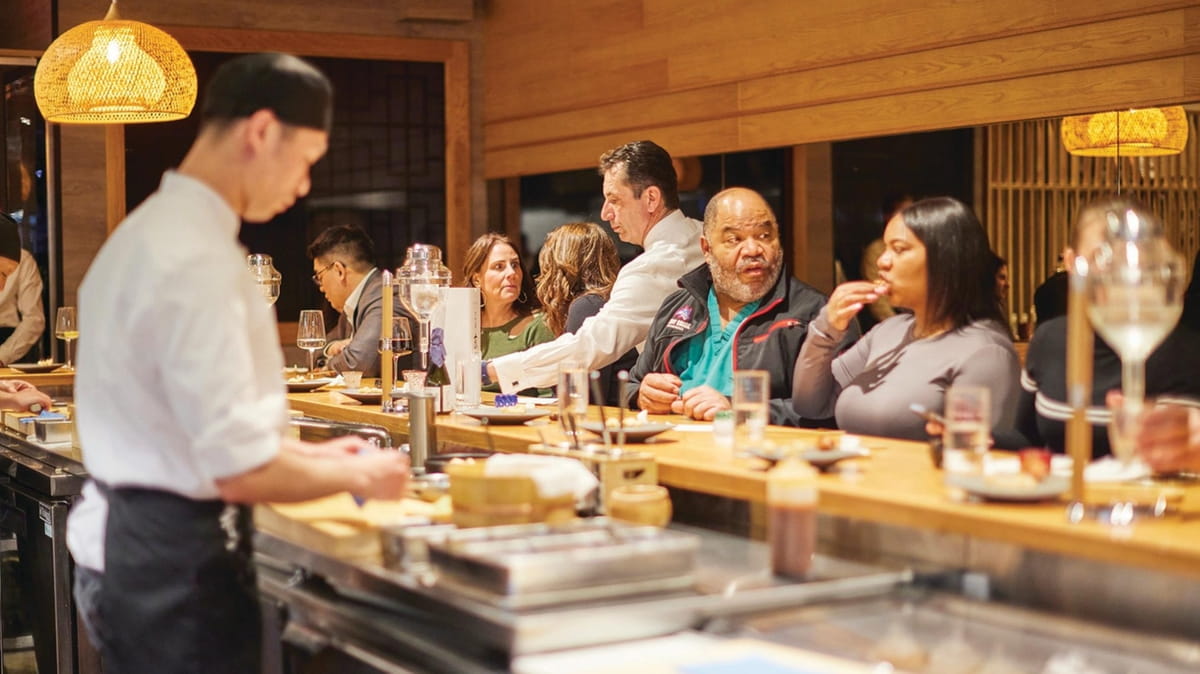Rather like English, which is often called easy to learn but difficult to master, Foodish is a language that’s spoken everywhere and understood almost nowhere. It’s full of misnomers, as anyone who’s ever gone looking for ham in hamburgers or pine in pineapples will attest, along with terms obscure (semifreddo, lardo) or misused—or used loosely—so often they’re essentially meaningless (authentic, locally sourced).
Which brings us to omakase, one of the thornier terms in the contemporary culinary lexicon. Literally “I’ll leave it up to you” in Japanese, it’s a style of eating in which the diner chooses not to choose what to eat, instead leaving the decision-making entirely up to the chef.
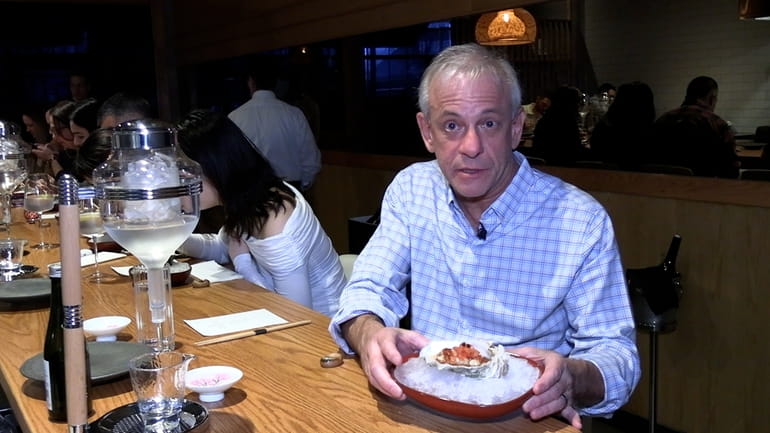
That chef won’t feed you just anything: As he or she typically works in a Japanese restaurant, there will probably be sushi, though not always. Omakase is very let-it-be, very Zen, very what-happens-happens. And this is very unsettling to a certain class of restaurant patron, namely those who define dining out as eating exactly when and what they want. But if you’ve ever let a sommelier choose the wine, told the barber to do whatever, let someone pick out your clothes or even just purchased one of those $10 mystery grab bags at Michael’s, you’ve done omakase.
It can be fun, different and — insofar as it offers freedom from the tyranny of decision-making — liberating, but is that all that defines omakase? Hardly. The term invites a wealth of interpretations, as evidenced by the following four restaurants, each with its own definition of omakase.
Assorted nigiri at Umami in Huntington. Credit: Yvonne Albinowski
Sean Chen is a friendly guy with a warm smile, just the sort you could imagine engaging in a freewheeling conversation about all things fish. But he is also a serious sushi chef, here defined as someone who briefly, if gladly, offers details on dishes yet is otherwise a taciturn presence. Thus, sitting at Chen’s five-seat counter at Umami in Huntington feels a bit like church, but in the best sense—his omakase is a religious experience. For while the atmosphere is pin-drop quiet, the dishes themselves speak volumes, making a persuasive case not just for Chen’s knife skills but omakase itself as something other than an occasional splurge (prices start at $50 for nine courses).
There’s no finer, more complex or, well, indulgent mouthful on the Island than the Kumamoto oyster on the half-shell Chen dresses simply with lemon and sweet vinegar, unless it is his dish of fatty tuna, uni (sea urchin) and osetra caviar, or the tiny dish of toro tartare topped with a quail egg and truffle oil (“stir it up!” he coaxed with a grin), or the A5 Wagyu nigiri with truffle shavings and caviar. Still, none of it prepares you for a course which, despite its presence in the middle of the pack, is the taste equivalent of a fireworks show’s explosive finale, packing in everything from bluefin to Wagyu to uni to truffle oil, the whole shebang loaded onto a sweet cracker almost too light to hold it all. It’s the kind of life-changing bite that sushi lovers the world over live for, one capable of eliciting identical gasps of delight from complete strangers, all of whom swiftly become fast friends under Chen’s watchful eye.
Chef Sean Chen prepares fish for omakase at Umami in Huntington. Credit: Yvonne Albinowski
Though diminutive and mild-mannered to a fault, there’s something unmistakably theatrical about chef Osan Weng, his presence heightened by the stagy lighting at Sora Omakase, which opened in Stony Brook in January. Menu cards printed in English and perfect kanji (the Japanese writing based on Chinese characters)—a sort of Playbill of the courses to come—add to the effect, as does Weng’s adroit use of pauses, so much so he might count Harold Pinter among his influences.
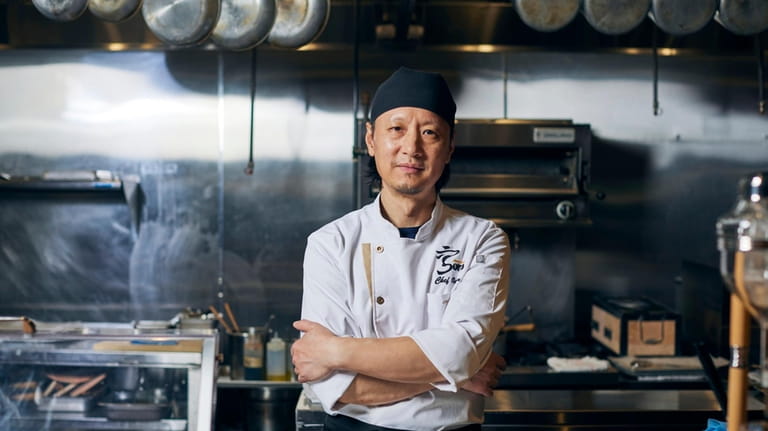
Chef Osan prepares fresh raw fish at Sora Omakase in Stony Brook. Credit: Yvonne Albinowski
“The first course: maguro yamaimo kake with wasabi dashi soy,” he said sotto voce, placing a bowl of soup before each diner, who admired the cubes of wine-colored tuna and grated Japanese yam peeking above the surface of a soy dashi sea. Pause. Still pausing. Then: “Now, take a spoon and mix everything together.”
Simply stirring the dish coaxed a smoky sweetness from it, a change as sublime and remarkable as the one visited on Sora’s teacups, with their painted cherry tree branches that magically sprouted pink blossoms when the cups were filled with sake. It was all part of a 13-course, $95 evening of awe inspired by magic and whimsy, and even more so by the thick planks of fish Weng produced from a wooden box behind the sushi counter. This treasure chest of flown-in headliners included pearlescent shima aji (striped jack), which he dressed with shiso and wasabi—produced on the fly by rubbing Japanese horseradish on a wooden grater in a circular motion.
Pacific oysters with tomato salsa and Sansho pepper at Sora Omakase in Stony Brook. Credit: Yvonne Albinowski
Also in the box: delicate fillets of yellowtail, blushing-pink skipjack tuna he would serve with its silver skin still attached and proudly pink otoro, the fattiest cut from the bluefin, the king of sushi. Weng paid his respects to the latter first by addressing it with a glinting knife and slivery precision, then folding slices around sushi rice to which he’d given a gentle squeeze, and finally, topping the whole thing with a thin squirt of truffle paste and a tweezer of gold leaf. “Hai dozo!” he proclaimed upon serving his prized specimens, depositing nigiri before diners with all the bravura, and sense of moment, of a Frenchman’s “voilà!”
That great art might emanate from a tiny studio at the back of a Roslyn Heights seafood market seemed utterly impossible, but only until the first course arrived—a bull’s-eye of caviar carefully spooned onto a disk of minced bluefin tuna floating in a moat of wasabi and soy sauce at the bottom of a martini glass, the whole thing garnished with a single skewered mountain peach (the tangy-sweet Japanese bayberry). It was a dish exquisite in appearance and flavor, and the work of Sushi by Kuryu’s Teruo Yoshioka, a Nagoya native and former sous chef at Nobu in Manhattan. His studio, such as it is, lines the back wall of Roslyn Seafood Gourmet, and prices start at $100 for a four-course omakase.
Chef Teruo Yoshioka prepares fresh raw fish for omakase at Sushi by Kuryu in Roslyn. Credit: Yvonne Albinowski
Yoshioka’s moves were balletic, and he interacted sparingly with adoring fans on the other side of the sushi counter (just four stools), and not at all with patrons at the tables added when he arrived in 2022. “People don’t expect this place, they are surprised,” said Yoshioka as he constructed the second course, a deceptively random-looking tumble of seared pieces of salmon over grilled zucchini, dressing each plate with a blistered shishito pepper, baby greens and a miso sauce that was glorious in its dance of spicy and sweet. The next featured seaweed-flecked rice topped by first-rate uni and salmon roe, all of it sandwiched between a pair of the round, crispy rice-flour wafers more commonly found in monaka, a Japanese dessert. “Eat it like a burger,” encouraged Yoshioka, offering a rare bit of guidance and watching with evident pride as his diners crunched their way to the meltingly fresh centers.
Not every plate that followed would be so impressive visually—how much can you do with nigiri, after all?—but even then, Yoshioka’s flavor choices were inventive and flawless. The snapper was fragrant with shiso, the sea scallop spiked with citrusy yuzu, sea salt and lemon, and every cut of tuna tasted like it had been caught off the coast of Spain that morning. It was akami as art, cuisine as culture, a feast for the soul and senses.
Bluefin toro tartare, sushi Monaka and marinated bluefin tuna with honey mustard at Sushi by Kuryu in Roslyn. Credit: Yvonne Albinowski
Last October, Long Island’s second Kissaki opened in Manhasset (the first debuted in Water Mill in 2020) with a clear and clearly ambitious idea for omakase, one that involved sushi chefs preparing dishes tableside in the dining room. As executive chef Edgar Valerio worried over the composition, number and sequence of courses (prices start at $95 for six courses), the concept proved difficult to execute. “It’s supposed to be a progression, to take you on a flavor adventure, put you in a different mindset, transport you somewhere else,” said general manager Frank Botta. The vibe was distinctly at odds with the sound of omakase carts clacking across a wooden floor, bringing the bustle of a Japanese train station to its stately moss-green dining room.
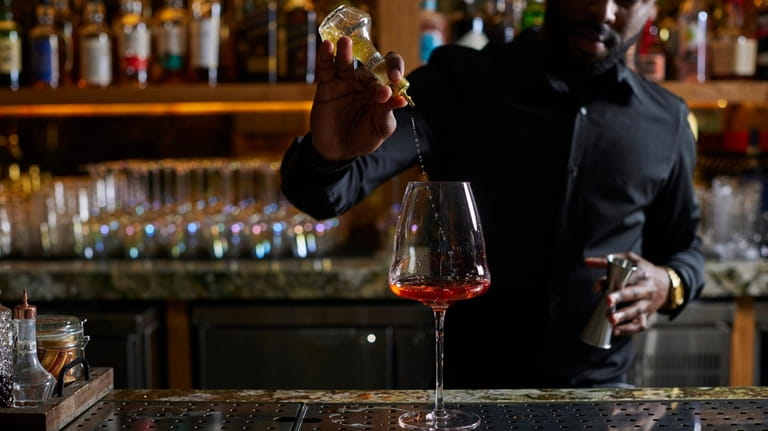
The Kobe spritz at Kissaki in Manhasset. Credit: Yvonne Albinowski
After months of tinkering, Kissaki opted for an approach that stationed chefs in a basement kitchen (“just 20 feet below and seconds away,” as Botta put it), relying on well-schooled servers like Chor Chotinaruemol to explain it all. The result was an evening at once exciting and elegant, from a predinner Kobe Spritz (grapefruit juice and sake get the Aperol kiss) to dessert, an imaginative and un-Japanese torrija, Valerio’s take on Spanish French toast given the blowtorch treatment. In between were five courses ranging from a generous helping of king crabmeat and pickled tomatoes to glittering slices of kinmedai (golden eye snapper) that diners were invited to dip and swish shabu-shabu style in bowls of rich soy dashi. It seemed perfect that one course should feature five traditional nigiri—and come with instructions that diners consume the tuna pieces from lean akami to fatty otoro “in that order,” said Chotinaruemol—and perfect, too, that this course should be followed by another with five out-of-the-box takes, from creamy sea scallops dotted with charcoal salt to sweet botan shrimp topped with the dark yolk of a Jidori hen. Like the other Island omakase journeys before it, Kissaki’s resembled nothing so much as a great song, its musical notes appearing both random on paper and inevitable in hindsight.
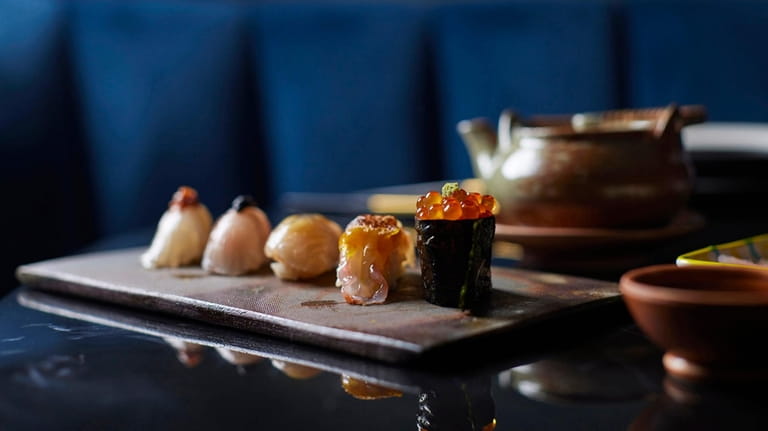
Nigiri is part of the omakase experience at Kissaki in Manhasset. Credit: Yvonne Albinowski
OMAKASE 101
The term “omakase” was popularized in the 1990s by sushi restaurants in Japan. A set meal at a set price, it varies day by day and is based on what fish is freshest and what inspires the chef.
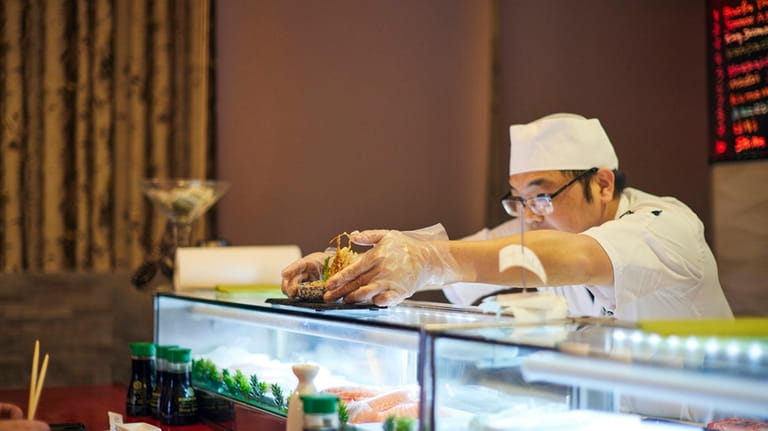
Sean Chen prepares omakase at Umami in Huntington. Credit: Yvonne Albinowski
- Make a reservation Many restaurants that serve omakase are small, with limited seating—sometimes only a few stools at the bar. This allows the chef to get to know the individual diners and what they like.
- The cost Omakase isn’t cheap, but then again, why should it be? You are paying for top-quality, pristine seafood and the artistry and training of a chef who can coax every nuance of flavor out of it—typically, right before your eyes. That said, there are places that offer a set-price omakase (like the restaurants mentioned in this story), often with supplemental charges for a drinks pairing (generally a good idea). If there is no set price, let the restaurant know your price range, so the chef can tailor the meal to your budget. Tips are not included in a set-price omakase.
- Timing is everything Don’t try to cram in omakase if you’re in a rush—it’s a multicourse meal, after all. At the same time, don’t dawdle or take umpteen photos for social media. The chef is serving you a succession of dishes at the perfect temperature, and they are meant to be eaten in a few bites. Think of omakase as a culinary conversation between you and the chef.
- Novices welcome If you’re not that familiar with sushi or Japanese food in general, omakase takes the guesswork out of what to order for a satisfying meal. You’re in the hands of an expert, so relax.
- No need to add anything Unless a dipping sauce has been provided, know that each dish has been perfectly seasoned and you shouldn’t need soy sauce or wasabi, for instance.
- Nigiri know-how Nigiri, the most common type of sushi, consists of an oblong or oval mound of seasoned rice with a slice of raw fish on top. (Cooked toppings include grilled eel and boiled shrimp.) The standard method for eating nigiri is to pick it up with your fingers and eat it in a single bite. If soy sauce is provided, turn the nigiri upside-down and touch only the fish when dipping and eating in order to get the full sensory experience. It also keeps the sushi from falling apart.
- Tuna terms There are a number of tuna varieties that are used in sushi, including ahi (which can be either yellowfin or bigeye) to the highly prized bluefin. When it comes to different cuts of tuna, akami, which comes from the top loin, is the leanest and mildest, with firm, dark-red flesh. Chutoro is a slightly paler, fattier cut, typically from from the stomach or lower back of the fish. Otoro, from the fatty belly of the bluefin tuna, has an unmistakable melt-in-your-mouth quality.
THE DETAILS
Omakase seatings are often limited, so it’s best to call ahead and see if reservations are required or suggested.
KISSAKI 407 Plandome Rd., Manhasset; 516-464-4884 | explorekissaki.com
SORA OMAKASE 1113 Rte. 25A, Ste. 3E, Stony Brook; 631-551-5544 | soraomakase.com
SUSHI BY KURYU 444 Willis Ave., Roslyn Heights; 646-283-9611 | kuryunyc.com
UMAMI 329 Main St., Huntington; 631-421-4726 | umamihuntington.com
